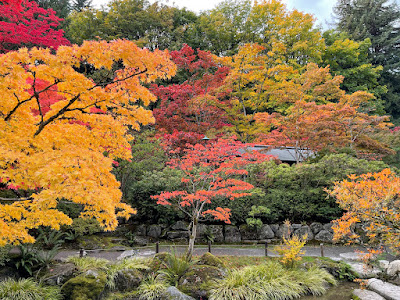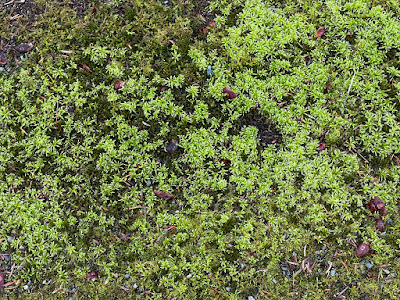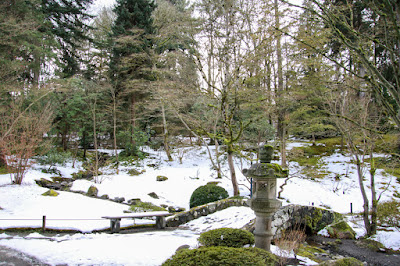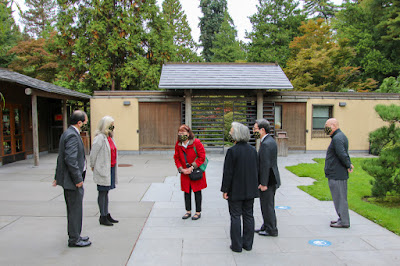Find on this page: The Garden in October Maple Viewing, Early May, Late April, Early April, March, February Snow and The Ginkgo Planting of Oct. 2020.
Oct 2021 - Maple Viewing
Fall color is on full display for Maple Viewing: Oct 8 - 17! These photos were taken on Saturday, Oct 16.
Early May 2021 - Azaleas Abound
What a difference a mere week can make in the Japanese Garden as a riot of Azaleas burst into color!


North end bright pink & red Azaleas burst out.

 Wisteria and Iris flowers emerging
Wisteria and Iris flowers emerging

Primula

Corolla Yellow Azalea

Mid & Late April 2021 - What's Blooming
Every week brings changes to the garden and even though Japanese Gardens are not known for their flowers, our Seattle garden has more than its share. By mid April Camellias, Osmanthus, Magnolia, and cherries were in full bloom and while Rhododendrons and Azaleas were fast approaching. (All photos by Peggy Garber)


Osmanthus fragrance filled the air.


Magnolia blooms glowed in the sun.




Rhododendrons began to emerge.


The Orchard Cherries and Plumbs showed forth.



New leaves began to appear - bright red and yellow green.


By late April most of the trees had leaved out
and the Azaleas and Rhododendrons added their riot of color.







The Wisteria began to develop buds amid the vibrant Azaleas.



And the Viburnum have been bursting out.




And the Ekianthus in the Roji by the Teahouse.


April 2021 - Early Spring Flowers
It was a gorgeous early April day in the Seattle Japanese Garden and many more visitors have come to that realization. Early spring flowers are starting to appear. It is lovely!
(All photos by Peggy Garber)
March 2021 - Early Spring
A March visit to the Seattle Japanese Garden reveals the structural beauty of the plantings with the promise of budding new growth. (All photos by Peggy Garber)

The camellias are the first to show their color. Their dark lustrous leaves contrast the new growth moss.

The usually hidden Stone Tower, Mountain Waterfall and Teahouse reveal themselves through the barely budding trees.
The clean bright rocks of the newly repaired shoreline and rocky peninsula (suhama) almost glow under the cloudy sky.


...and the Wisteria is getting ready to put on buds.

The bright chartreuse of new growth contrasts against a stormy sky.

The yet bare branches of the Japanese Snowbell (Styrax japonicus) show prominently its cloudlike clusters of lichen and moss.
February 2021 Snow
Two melt days after a 12" snowfall, the Seattle Japanese Garden is still covered in snow. (All photos by Peggy Garber)
60th Anniversary Events
October 5, 2020 - Hiroshima Ginkgo Tree Planting
Coinciding with the October 5, 1960 planting of a cherry and a birch tree by the then Crown Prince Akihito and Princess Michiko of Japan, a small group of Seattle Japanese Garden supporters gathered to plant a Ginkgo Biloba tree. The small ginkgo sapling was grown from the seed of a tree that survived the 1945 bombing of Hiroshima and was donated to the garden by Green Legacy Hiroshima with a message of Peace and Hope.
A small group joined the celebration outside the garden while socially distanced and wearing black face masks printed with gold ginkgo leaves.
The garden was honored to have Mayor Jenny Durkin, Japanese Consul General Hisao Inagaki and his wife, Seattle Parks Superintendent Jesús Aguirre, and Arboretum Foundation Executive Director Jane Stonecipher attend and give remarks.
Speakers included: Jane Stonecipher;
Mayor Durkin;
Consul General Inagaki;
and Jesus Aguirre.
Susan Ott Ralph, Vice President of the Seattle Japanese Garden Docents Unit 86, told the story of how this ginkgo seedling came to our garden and presented a plaque from the Unit to be mounted on the stone beside the tree. (Read her Story below.)
Cara Izumi, Secretary of the Seattle Japanese Garden Docents Unit 86, read a message from Green Legacy Hiroshima to Seattle Japanese Garden.
"‘It makes all of us in the Green Legacy Hiroshima family very happy to think about the planting of a Hibaku-Jumoku on the beautiful grounds of the Seattle Japanese Garden. It is particularly meaningful that you are doing so on such an auspicious occasion here, but also during such a momentous year, as much in the United States as around the world. This is in keeping with the beauty but also the gravity of the message of the survivor trees, and even the birth of GLH itself, established in 2011 in the aftermath of the Great East Japan earthquake, tsunami and Fukushima nuclear accident. The message of the survivor trees of Hiroshima and Nagasaki so simple, yet so profound and universal — they embody, by their mere presence, our collective hopes for a world without the threat of nuclear weapons, and for celebrating the resilience and generosity of nature.
We wish you a beautiful planting and thank all those who have made this possible."
After the remarks, each of the speakers placed a shovel of dirt around the roots of the sapling.
Following the ceremonies, Jeanne Peterson, Chair of Seattle Japanese Garden Docents Continuing Education Committee, lead the Consul General and his party on a tour of the garden.
Tour group beside the birch tree planted by the Japanese Crown Princess in 1960.
Music for the tour was provided by Marcia Takamura, whose mother and father provided music at the Opening Ceremonies of the garden on June 5, 1960.
The new home of the Hiroshima Ginkgo biloba sapling.
The Story Behind the Ginkgo Tree Planting by Susan Ott Ralph
In 1945, the United States dropped an Atom Bomb on Hiroshima and later Nagasaki causing widespread destruction and lost of life. The trees burned and were blown over and the devastated area was completely black. Despite this, some of the trees managed to survive and to encourage the people. The Japanese architect, who was in the second grade when the bomb dropped, said “Everyone was really moved to see the green leaves.” As the city was rebuilt, the trees were treasured and given a special name, Hibaku-Jumoku which means survivor tree.
In 2011, Nassrine Azimi, a United Nations worker, and her friend Himoko Watanabe organized Green Legacy Hiroshima, a volunteer campaign to disseminate the seeds from these trees to a network of a network of international partners. Currently there are trees in 36 countries around the world promoting a message of Peace and Hope. Nassrine said “I thought this should all come together and be told a one narrative. It is too important a story. It cannot be forgotten.”
When I learned about Green Legacy Hiroshima, I loved the idea. I asked Jane Stonecipher if we could join as a partner. She was enthusiastic and everybody connected to our garden came together for this project. We were hoping to have a sapling that we could plant for our 60th Anniversary. However, the Agricultural Customs of the United States are very strict and it is just about impossible to import a sapling. But then, Nassrine told us that she had brought some seed from a ginkgo tree to San Diego about five hears ago when she visited her mother, Azar Azimi.
These seeds were from a tree located in Shukkei-en garden which was only 1300 meters from the epicenter of the bomb. The garden had been created by a Samurai Tea Master in the 17th century. The tree was over 200 years old when the bomb hit, burning the trunk, and after the blast the wind rushed into the center causing the tree to tilt and nearly fall over but it survived.
Azar had planted these seeds in a pot in her patio and she agreed to donate the young sapling to our garden. So, Cara Izumi and I went to San Diego and met Azar, who was sad to say goodbye to her tree. We promised her to take good care of it. She was planning to come to this ceremony but couldn’t because of the Covid. So then we drove the sapling to Seattle and delivered it to Ray Larson, the Curator of the University of Washington collection, where he and staff have cared for it for the last 8 months. And it turned from a bare stick to this green sapling.
Meanwhile, the volunteer Docents of the garden have donated a plaque to set into this stone here. I’ll end with these words:
The Mother Tree in Shukkei-en garden in Hiroshima, Japan.
A Side note: Steve & Peggy Garber visited this same tree on May 27, 2010 with long-time Japanese host friends.
Video of the Ginkgo Tree Planting Ceremony
Click the link to see the video of the ceremonies on the Seattle Japanese Garden website:






































































































No comments:
Post a Comment
Note: Only a member of this blog may post a comment.